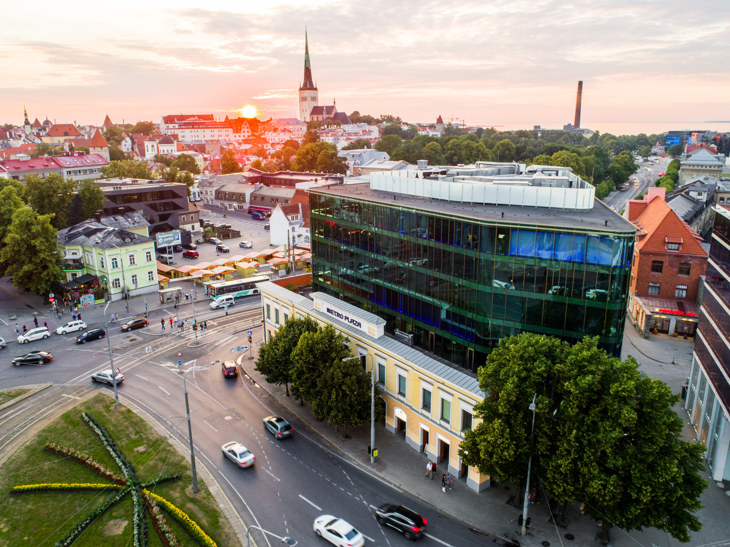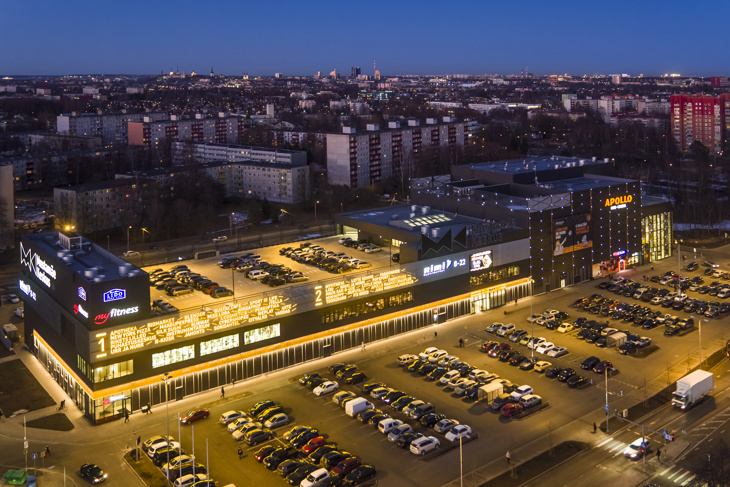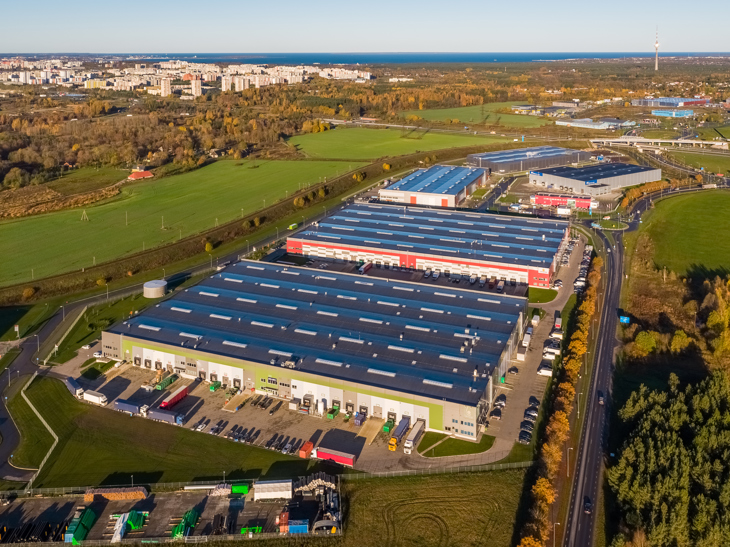How Skype and self-driving robots are technifying the Baltic neighbourhood

Estonia is building a reputation for firsts. A decade and a half ago, when most of us were still fumbling in our pockets for coins for parking meters, Estonians were among the first in the world to pay by mobile phone. Before Satoshi had articulated the concept of blockchain, Tallinn was testing equivalent “hash-linked time-stamping” to secure its data against cyber attack.[1] More recently, the country became the first to issue e-resident ID cards complete with cryptographic key and PIN code.[2]
Not that you’d know you’re entering the “most advanced digital society in the world,” as Estonia has been crowned by Wired, from the look of most of Tallinn’s real estate, fusing gothic with Stalinist Classicism. Yet it’s here that some of the best used and most advanced global IT services from Skype to payments firm TransferWise[3] to self-driving pizza delivery robots have been born, spurring a wave of technology-focused businesses establishing in this tiny country.[4]
In neighbouring Latvia, the decades-long trend of migration to EU countries is now superseded by migration towards the capital, Riga, from the countryside. Lithuania’s relatively young and highly educated population has international companies vying to recruit graduates as Vilnius becomes a growing hub for law and finance firms among other service providers.
In order to attract and retain talent, recruiters need to offer the aspiring workforce offices that are pleasant, energy-efficient, bright and airy, instead of the tired offices of even 15 years ago. This is where we see the demand continuing to grow and so our portfolio focuses on new office developments that tick all the right boxes for millennial professionals.
Although older properties can be bought relatively cheaply and will still provide a good return, this is not where the future lies. Rents on older buildings are typically falling or struggling to keep up, while they’re increasing on the higher quality properties in spite of a robust supply of new buildings. Across the three Baltic capitals, there is around 1,000,000 square metres of office space less than 10 years old, with a further 200,000-250,000 square metres in the pipeline for this year, according to Colliers.
Investment surge
Total investment in Baltic commercial real estate jumped 19% last year to EUR 1.1bn, with forecasts showing continued increases ahead. This has had the effect of making Baltic real estate markets more stable and predictable, which is good news for local and international investors alike.
Although there may be some yield compression as increased market liquidity lifts prices faster than rents, it’s unlikely to be anywhere near the levels seen in bigger cities such as Stockholm, Hamburg or Frankfurt. The Baltic market is still too small to attract the attention of major German and continental European real estate investors. That will no doubt change as the market matures – but for now, happily for us, most of the institutions are content to take advantage of expertise on the ground by going in via investment funds.
East Capital has more than 20 years of experience in successfully investing in emerging and frontier markets, and is one of the largest real estate investors in the Baltics. Within the property sphere, we operate as a real estate company, with our own internal resources that cover investment origination, legal expertise, financial services to the operating property companies, tenant management, as well as project and construction management. In this way, we maintain close relationships with our tenants, servicing them as they grow and their needs develop. All of this ultimately translates into longer-term relationships with satisfied tenants – and better returns.
Half the rent, twice the yields
From Helsinki, Tallinn is less than 100 kilometres away, and this region is generally a very attractive place to run a business – not least from a taxation perspective. In the Nordics, there has been a rapid increase in rents, especially in the office segment. The Baltic markets have shown more modest growth, and this has increased a differential that in our minds should now start to narrow over time. Rents won’t converge with Stockholm overnight but we expect that in time there will be little difference between the Baltics and other central European markets, which would imply a 30-50% increase locally.
Typical office rents of EUR 13-17 per square metre per month are lower than in Warsaw or Prague, at EUR 20. In Helsinki, they are around EUR 30-40, while in Stockholm, you would be looking at EUR 60-70. Top of the range offices in the Baltic capitals yield between 6-6.5%, about twice the yields in the Nordic capitals, while retail provides 6.4-6.5% and logistics properties earn 7.7%, according to Colliers.
As Estonia, Latvia and Lithuania are all members of the EU’s Eurozone, currency hedging costs for euro investors are zero. That’s not the case in Poland or the Czech Republic, which, like Sweden, are outside the Eurozone, making currency hedging a cost that investors must factor into long-term forecasts.
March to convergence
Overall, returns from Baltic real estate are already higher than what is available elsewhere in the Eurozone, and this gap is likely to widen as economic growth in the Baltics outpaces western peers.
Since 2000, GDP has expanded by 77% in Estonia, 84% in Latvia and 95% in Lithuania, the largest of the three economies. While the global slowdown and recession a decade ago was deeper here than in western countries, reductions to public spending made the dip in growth short-lived and the Baltic economies are once more continuing their march to convergence with western GDP levels. Average growth in recent years has been a solid 4-5% per annum.
The economic momentum means plenty of opportunities across the real estate spectrum and, as a result, we can cast our net wide. The market is less segmented in the Baltics than in the more established Nordics, where we see separate investments and funds targeting purely logistics, retail, hospitality, offices or public services properties, for example. Similar trends may well follow in the Baltics as the market matures.
Retail is facing challenges everywhere as the nature of shopping changes and the high-tech Baltics aren’t immune from such shifts. Retail space in Tallinn, Riga and Vilnius spans around 2,000,000 square metres, and more than half of that is in shopping centres – with the area in Tallinn among the highest in Europe per capita.
Inevitably, some forms of traditional retailing will die out, while the ones that survive and thrive will be those that adapt to consumer behaviour, focusing less on products and more on experiences. More floor space is being taken up by cafes and restaurants, cinemas, gyms and space to work over a coffee.
This integration of retail and lifestyle drives us to look at investments in shopping centres near densely populated centres. One of our real estate funds invests in the Mustamäe Keskus shopping centre in Tallinn. High-rise apartment blocks are nearby and people are able to walk to the conveniently located shops and leisure facilities.


From a low base
E-commerce is taking off and this is reflected in the real estate market. Warehouses and logistics centres fulfil our online orders, and returns and distribution depots are in keen demand. Our funds invest in one of the largest logistics parks in Tallinn, called Nehatu Logistics Park, with tenants including Post 11 and Boomerang Distribution, which services hundreds of global e-commerce companies.
The Baltic region’s position as a cost-competitive outsourcing destination is complemented by integrated IT solutions and infrastructure, and its strategic location in northern Europe with access to the Nordics, continental European and the large eastern markets such as Russia and Poland.
Although the Baltic countries are small, they certainly punch above their weight. Rising growth and prosperity are driving a growing supply of high quality properties in all three key segments: office, retail and logistics. Rents are rising from a low base, and initial yields are high compared to other markets. All three markets have adopted the Euro and public finances are sound. The economic and political situations look more stable too, helping economic growth to outstrip western Europe and entice international business. Beyond changing our virtual world, the Baltic tech boom is transforming good old bricks and mortar.
[1] Invest in Blockchain, "Estonia, A Blockchain Model For Other Countries", 4 January 2018
[2] Wired, "Concerned about Brexit? Why not become an e-resident of Estonia", 27 March 2017
[3] CNBC, "Fintech start-up TransferWise reports second year of profit, revenue almost doubles" , 10 September 2018
[4] Visit Estonia, “Top Estonian technologies changing the world", 12 July 2018







